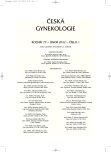Non-invasive monitoring of the timing of early embryo cleavages – objectively measurable predictor of human embryo viability
Authors:
D. Hlinka 1; S. Lazarovská 1; J. Rutarová 2; M. Pichlerová 1; J. Řezáčová 2; M. Dudáš 3
Authors‘ workplace:
Prague Fertility Centre, Praha
1; Ústav pro péči o matku a dítě, CAR, Praha
2; Univerzita P. J. Šafárika, Institute of Biology and Ecology, Košice
3
Published in:
Ceska Gynekol 2012; 77(1): 52-57
Category:
Original Article
Overview
Objective:
The evaluation of the developmental abilities of human embryos according to the timing of their early mitotic cleavages.
Design:
Retrospective study.
Setting:
Prague Fertility Centre and Institute for Care of Mother and Child, CAR, Prague.
Methods:
The embryos obtained in IVF program were used for further observations and subjected to automated time-lapse monitoring (PrimoVision, Cryo-Innovation, 1 picture/10 min, intermittent white-light illumination) under standard cultivation conditions (37.0 °C, 5% CO2 in humid air). Image sequences were digitally recorded for later use. For intravital spindle detection we used polaryzing microscopy (Oosight, Research Instruments) and Hoechst 33342 fluorescent dye for intravital chromatin visualization. A total number of 180 human embryos which gave a vital pregnancies (FHB, fetal heart beat) were analysed retrospectively for timing of early cleavages. In our study, the exact timing of the four interphases (IP) and synchrony of sister cell divisions (ID, interval division) occurring after fertilization were identified and manually recorded. Interphases: IP1 was defined as the period from fertilization till 2 cell stage. IP2 between 2 and 3 cells stages, IP3 between 3 and 5 and IP4 between 5 and 9 cells embryo.
Interval division:
ID2 was recorded as a time interval between 3 and 4 cells, ID3 between 5 and 8 cells and ID4 between 9 and 16 cells stage embryos.
Results:
In the embryos giving viable pregnancies, the durations of IP1 was 20–26 hrs. IP2 was 10–12 hrs, IP3 was 14-16 hrs and IP4 was 20–26 hrs. In these embryos, the sister blastomeres cleaved in a very synchronous manner. The duration of ID1 was recorded to varry from 120 to 210 min. ID2 from 20 to 60 min., ID3 from 120 to 240 min. and ID4 from 230 to 360 min.
Conclusion:
The viable embryos cleave in a very similar time pattern which can be defined and applied as referencial value. Non-invasive monitoring of the timing of early embryo cleavages can be used as an objectively measurable predictor of human embryo.
Key words:
noninvasive embryo imaging, time-lapse in human embryos, cell cycle analysis, embryo selection criteria.
Sources
1. Brezinova, J., Oborna, I., Svobodova, M., et al. Evaluation of day one embryo quality and IVF outcome – a comparison of two scoring systems. Reprod Biol Endocrinol, 2009, 3,7. p. 9.
2. Dudas, M., Hlinka, D., Dankovcik, R., et al. Combining novel experimental and bioinformatic tools for the advancement of preimplantation genetic diagnosis. In: Pilka, L., Lesnik, F. (Eds.), Reproductive medicine - Presence and perspectives. 2009. Olomouc: Naklad. Olomouc, Inc., p. 176-194.
3. Kilani, S., Cooke, S., Kan, A., et al. Are there non-invasive markers in human oocytes that can predict pregnancy outcome? Reprod Biomed Online, 2009, 18, 5, p. 674-680.
4. Kiessling, A. Timing is everything in the human embryo. Nature Biotechnol, 2010, 28, p. 1025–1026.
5. Hlinka, D., Dudas, M., Rutarova, J., et al. Permanent embryo monitoring and exact timing of early cleavages allow reliable prediction of human embryo viability, P-176 – Abstracts of the 26th Annual Meeting of the European Society of Human Reproduction and Embryology, Rome, Italy, 27-30 June 2010, 25, suppl. 1.
6. Magli, MC., Gianaroli, L., Ferrarettim, AP., et al. Embryo morphology and development are dependent on the chromosomal complement. Fertil Steril, 2007, 87, p. 534-541.
7. Nagy, ZP., Janssenswillen, C., Janssens, R., et al. Timing of oocyte activation, pronucleus formation and cleavage in humans after intracytoplasmic sperm injection (ICSI) with testicular spermatozoa and after ICSI or in-vitro fertilization on sibling oocytes with ejaculated spermatozoa. Hum Reprod, 1998, 13, p. 1606-1612.
8. Sakkas, D., Shoukir, Y., Chardonnens. D., et al. Early cleavage of human embryos to the two-cell stage after intracytoplasmic sperm injection as an indicator of embryo viability. Hum Reprod, 1998, 13, p. 182-187.
9. Scott, L., Finn, A., O`Leary, T., et al. Morphologic parameters of early cleavage-stage embryos that correlate with fetal development and delivery: prospective and applied data for increased pregnancy rates. Hum Reprod, 2007, 22, 1, p. 230-240.
10. Tesarik, J., Kopecny, V., Plachot, M., et al. Early morphological signs of embryonic genome expression in human preimplantation development as revealed by quantitative electron microscopy. Devl Biol, 1988, 15, p. 128.
11. Wong, CC., Loewke, KE., Bossert, NL., et al. Non-invasive imaging of human embryos before embryonic genome activation predicts development to the blastocyst stage. Nature Biotechnol, 2010, 28, p. 1115-1121.
Labels
Paediatric gynaecology Gynaecology and obstetrics Reproduction medicineArticle was published in
Czech Gynaecology

2012 Issue 1
Most read in this issue
- Is the hysteroscopy the right choice for therapy of placental remnants?
- To conclude knowledge about new colposcopic signs – ridge sign and inner border.
- Risk factors for recurrent disease in borderline ovarian tumors
- The psychosocial needs of newborn children in the context of perinatal care
